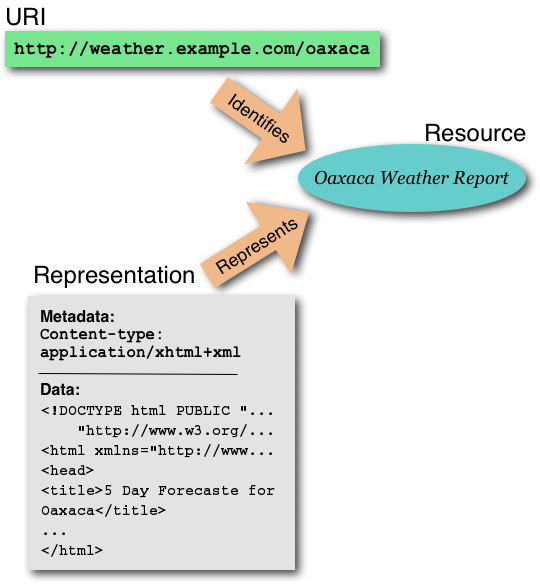Introduction to Hypermedia and Web-based content management
Step 1: Vannevar Bush
Consider a future device for individual use, which is a sort of mechanized private file and library. It needs a name, and, to coin one at random, "memex" will do. A memex is a device in which an individual stores all his books, records, and communications, and which is mechanized so that it may be consulted with exceeding speed and flexibility. It is an enlarged intimate supplement to his memory.
Vannevar Bush: As We May Think
Step 2: The mother of all Demos
Step 3: Ted Nelson & Xanadu
Other landmarks
web 101
Three core elements:
-
Web is composed of Resources.
- Resources are identified with URIs.
- Representations of Resources are created upon User Agent's request.
Architecture of the World Wide Web

Core Technologies
-
HTML - Hypertext Markup Language
- CSS - Cascading Style Sheets
- JPG/PNG/GIF - images
- HTTP - Hypertext Transfer Protocol
- Javascript
CMS - Quick Intro to Key concepts
What is content?
"What is 'content'? Raw information becomes content when it is given a usable form intended for one or more purposes. Increasingly, the value of content is based upon the combination of its primary usable form, along with its application, accessibility, usage, usefulness, brand recognition, and uniqueness."
Content. Management. System.
”Content, therefore is information that you tag with data so that a computer can organize and systematize its collection, management, and publishing. Such a system, a content management system, is successful if it can apply the data methodologies without squashing the interest and meaning of the information along the way.”
Title
"A CMS is a tool that enables a variety of (centralised) technical and (de-centralised) non technical staff to create, edit, manage and finally publish (in a number of formats) a variety of content (such as text, graphics, video, documents etc), whilst being
constrained by a centralised set of rules, process and workflows that ensure coherent, validated electronic content."
Example Systems
Plethora of options exist for implementing a Content Management System.
Let's have a look on some open source & free options first.
Three Examples
Comparing popularity
Stepping up to enterprise scale?
Gartner CMS Magic Quadrant
Adobe Marketing Cloud

Scale-free resources
"t’s no secret that Adobe CQ is the most expensive CMS. Adobe said during their recent partner summit that the average CQ deal is $450,000 in license with the total implementation cost of over $2m USD. - See more at: http://www.acquia.com/blog/why-are-mid-market-companies-still-looking-adobe-cq#sthash.5Kc4XqL9.dpuf"
Title
Developing a Content Management solution: where to start?
Lean startup

Case Verkkokauppa.com
Hänen mukaansa verkkosivujen tekeminen ja ylläpitäminen on yhtiön ydinbisnestä, jota ei voi ulkoistaa. ”Ulkoistaminen ei tule kysymykseenkään. Emme ylipäänsä voi erottaa it:tä ja liiketoimintaa toisistaan. Ilman it:tä homma ei pyöri lainkaan. It on meille tärkeä kilpailutekijä asiakkaiden tarpeiden ymmärtämiseen.”
Tietoviikko (2011):
Case Verkkokauppa.com
"Me ollaan aloitettu puhtaalta pöydältä, ja pöydän rungoksi on valittu verkkokauppa", Seppälä sanoo. [...]
"Me tulkitsemme asiakaskäyttäytymisestä kertovia lämpökarttoja samalla, kun he vasta miettivät varastojaan."
Helsingin Sanomat (2014): Verkkokauppa.com takoo tulosta
Alternative Approaches
Discussion
-
Depending on the type of the business, CMS can be "only a CMS" or at the very core of the business
- CMS can provide a way to keep in touch with the customer and the demand, existing or new, through analytics
- During the age of social media, CMS is only one part of the equation
- Build, Measure, Learn
- What is the most important thing we need to implement into the CMS next?
- Did we succeed?
- Many of the major media companies, e.g., run an in-house development team that specifies functionalities and serves as a product owner
Conclusions
- The CMS thesis: every (Web-based) MIS is a CMS – but ready-made options are available in most cases
-
Selecting the approach to introduce a new CMS may be more difficult than ever
- If online engagement with customers is a core part of business, in-house development is still an option
- Build-Measure-Learn – no excuse to take this approach, right?
- Your conclusions?

